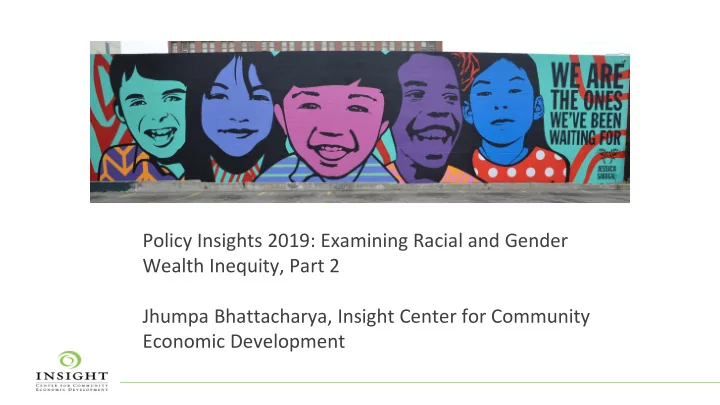

Policy Insights 2019: Examining Racial and Gender Wealth Inequity, Part 2 Jhumpa Bhattacharya, Insight Center for Community Economic Development
Millennial Women: Context • Representing 31.5 % of the female population, there are approximately 40 million Millennial women (born between 1980-1997) in the U.S today. • Coming of age during the Great Recession, the push for mass incarceration, unprecedented student debt levels, and changing workforce dynamics, Millennial women are 37 percent more likely than Gen Xers (those born between 1965 to 1984) to be living below the federal poverty line . • Most diverse generation the U.S has ever seen - close to 44% are women of color. • Millennial women are going to college at higher rates, and are increasingly the primary head of households. They are not benefitting from economic policies and systems built to meet the needs of men as primary breadwinners.
Clipped Wings: Data on Millennial Women Baby Boomers as young adults had twice • the wealth of young adults today. Median wealth holdings of single Millennial • men is still 162% greater than single Millennial women ($11,230 and $6,914 respectively). Single White Millennial men have close to • six times more wealth than single Black Millennial women.
KEY PROBLEM DRIVERS Pay Inequity and Increasing Student Changing Family Occupational Debt Structures Segregation Economic Mass Incarceration & Contributions to the Criminalization of Parent/Extended Poverty Family
Millennial Student Debt In the fall of 2017, women represented 56% of students nationwide, up from 42% in the 1970’s. • The current national student loan debt is $1.5 trillion dollars, two-thirds of which is carried by • women ($900 billion). Median student debt for Millennial women is $20,263 compared to $16,271 for Millennial men— • four times the levels held by the Baby Boomer generation.
Millennial Women’s Pay Inequity and Occupational Segregation Black Millennials earn 57 cents and Latinx • Millennials 64 cents for every dollar earned by White Millennials. While women make up about half the • workforce, they constitute 70% of employees whose jobs paid less than $10 per hour. Men were offered a higher salary than women • for the same job at the same company 63% of the time. Gen X women represented one in four people • working in STEM occupations. By 2017, that rate had fallen to one in five for Millennials.
Millennial Women’s Changing Family Structures 57% of babies born to Millennials in • 2017 were outside of marriage. “Motherhood cost” -- the physical, • emotional and financial costs of mothers taking time off of work to care for children -- is particularly significant for the Millennial generation.
Millennial Women’s Contributions to Family • 75% of Millennial caregivers are helping someone over the age of 50. • 25% of the nation’s Millennials are Latinx and 30% of them say they are supporting two or more generations of their family . • 58% of all Latinx caregivers taking care of persons aged 18 and over are women. • More than half of Black caregivers find themselves "sandwiched" between caring for an older person and a younger person under age 18. • With the increase of Millennial women being primary breadwinners and this being the most diverse generation we’ve ever seen, this is an important Millennial women’s issue.
Effect of Mass Incarceration and the Criminalization of Poverty for Millennial Women Millennial women are 10 times more likely to be • incarcerated than previous generations. The rate of incarceration for Black women is • almost double that for White women, and the rate for Latinx women is more than 20% higher than White women . Since 2010, over 48 states have either increased • their criminal fees, or adopted new fees, stripping wealth from Millennials. Even if women are not the ones being arrested • and/or fined, they are often the ones paying the fine, fee or bail money for their sons, brothers, partners, uncles etc.
STRATEGIES FOR ACTION Research & Elevate Broaden Support for Invest in Women’s the Specific Needs of Systemic Solutions Leadership Programs Millennial Women Work to Eliminate Fines Fund Bold, Innovative and Fees & Other Policy Interventions Consequences of Mass and Pilots Incarceration
Systemic Solutions • Ensure equal pay between men and women and tackle occupational segregation. • Increase access to affordable, high quality child care . • Promote debt-free financing for student loans and/or a lowering or elimination of college tuition costs . • Advocate for guaranteed comprehensive, expanded paid family leave for various types of employment.
Bold, Innovative Policy Interventions and Pilots • Guaranteed or Universal Basic Income (UBI) – a no strings attached direct cash benefit from the government to obtain a basic floor of living • Federal Jobs Guarantee – a guaranteed public sector job for everyone • Baby Bonds/Young Adult Trust Accounts – a government sponsored child trust account
Recommend
More recommend